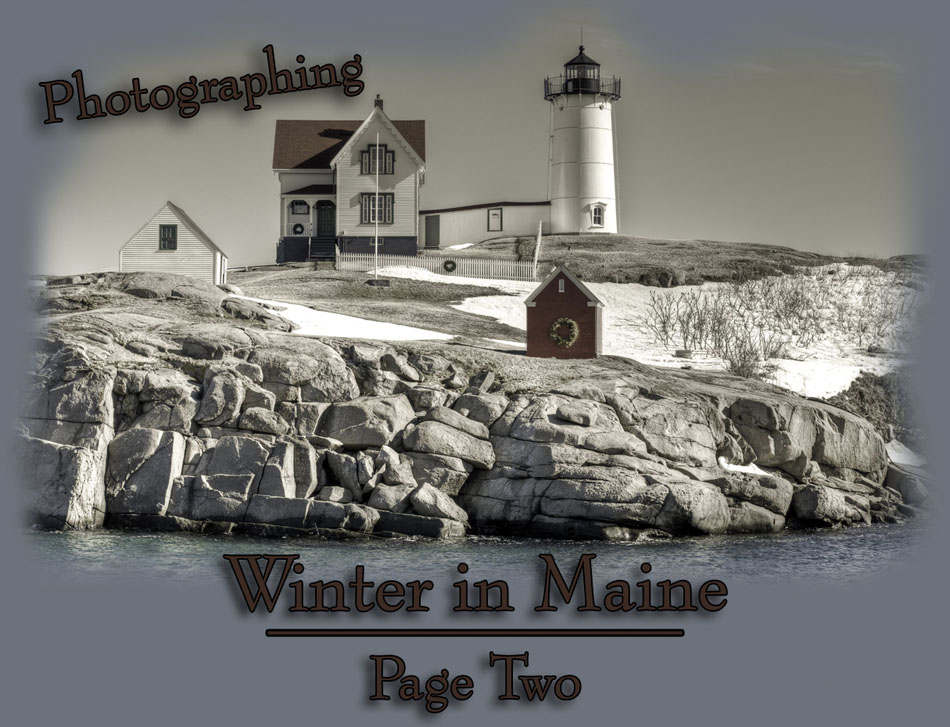
|
February 2011...
Winter going into February brought little relief from the cold or snowfall. Because I didn’t have plans to get out of state for some warmer imaging climes, I decided to make more of an effort when I could find time. With all the photographic possibilities I have around me I don’t avail myself of them as often as I should when I find myself in a normal work routine. I’d been fairly active up to this point and wanted to keep it up with the start of the new month. This page starts with some exposures around our neighborhood.
Neighborhood Views - Portland, Maine

|

|
January 2011...
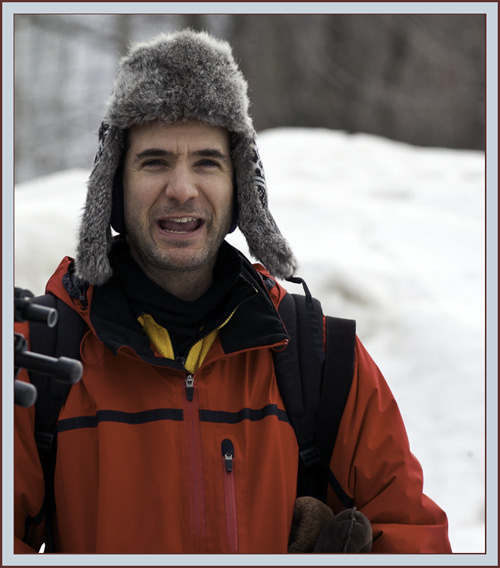
|
I’d been emailing back and forth with another birder and photographer, Chuck Homler, who lives and works in Saco. The last time I was in the field with Chuck was the summer before at River Point Conservation Area in Falmouth, where we were fortunate enough to locate and photograph the elusive Blue-winged Warblers there. We’d been in touch since then and decided to get together to seek out the Barrow's Goldeneye Chuck had reported in the Saco River near his office. We picked a Saturday, the 12th of February, to meet. I drove to Saco, picked him up and we started our day at the river. We planned on touring his familiar locations in the area. Chuck Homler Dressed for Winter - Saco, MaineCanon EOS 5d/EF 400mm F/5.6L, 1/400 second @ f/10, ISO 640. |
It was another bitter cold and windy day as we parked and checked out the river. Chuck’s office overlooks the river so he’s able to keep tabs on what can be found readily
enough – he’s had some interesting sightings this winter. The Barrow’s Goldeneye was spotted off in the
distance so we decided to wait around a bit to learn if we’d have
a closer imaging opportunity. A Common Goldeneye group was in the river closer to our location so using the snow bank for cover I set up my tripod and took some exposures
of them. I was hoping to photograph some Common Mergansers at this site also. These may be considered common but had not proven to be that whatsoever in front of my
lens. There was a pair in view all the way across the river. Later we drove around to the other side, climbed the snow bank but never had a chance for an exposure before
the ducks spooked and flew off – back to where we’d just come from of course…
Barrow's Goldeneye - Saco, Maine...Canon EOS 1Ds Mark III, 1/250 second at f/8, ISO 640, EF 600mm + 1.4X = 840mm with flash |

|
Saco River Views...
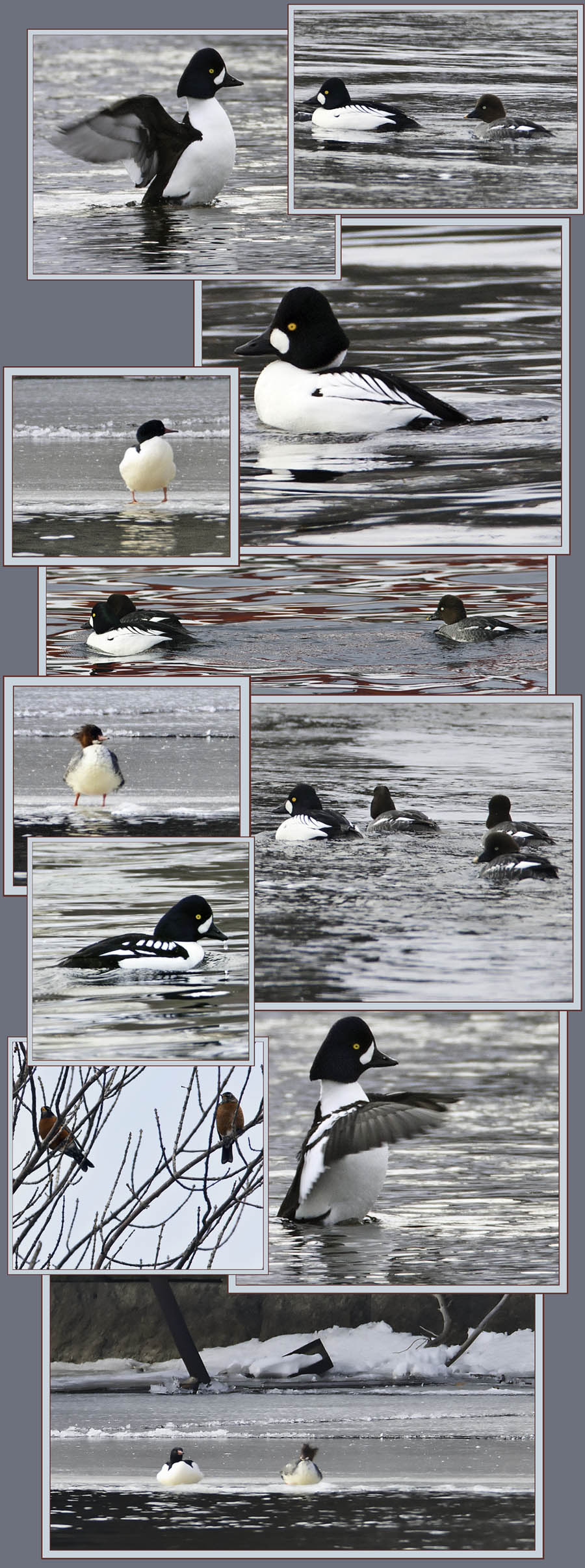
|

|
After leaving the area we drove to Camp Ellis and went down to the pier. As we opened the vehicle doors the wind grabbed and immediately flung them back – the wind near the river was miniscule in comparison to this site. However, there was a good deal of activity from what we could see as we geared up to check it out. It was cold but there were still a few braving the elements to look around the area –people strolling and dog-walking. I’d recently acquired a new lens and this was the first opportunity I had to experiment with it. Although the wind presented a problem, after photographing birds for a time I returned to my vehicle, pulled it out and got it mounted to have a look. This lens, a Canon TS-E 17mm f/4L, has the ability to tilt and shift making it ideal for architecture and landscape work, and is strictly manual focus. Posted below is my first exposure ever taken with this lens – from the pier looking below. This was another ‘suffering for art’ moment because I had to constantly take one or both gloves off often to make adjustments to the lens knobs - it was a cold day... American Wigeon - Camp Ellis, Saco, MaineCanon EOS 1Ds Mark III, 1/250 second at f/8, ISO 500, EF 600mm + 1.4X = 840mm. |
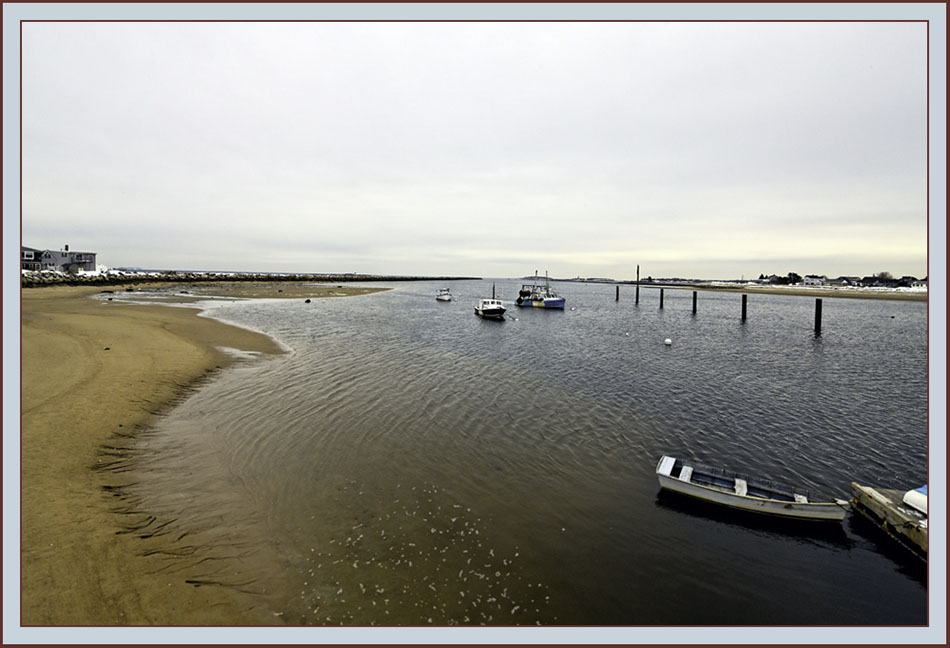
|
It may have been chilly and the wind was up but it didn’t appear to bother the bird life much – it was an active day. I was on one side of the pier taking a series of exposures
handheld on a White-winged Scoter when Chuck yelled out – he wanted me to hurry with my tripod to his side. He’d obtained a
quick look a pair of American Wigeon mixed in with a Mallard
flock that was moving off. We both managed to photograph these ducks. Other sightings included Common Goldeneye, many Herring Gulls of course, two or more
Horned Grebe, sometimes
fairly close in, Common Loons, Red-breasted Mergansers and far distant on the opposite shore, Chuck pointed out a
Red-necked Grebe. This bird was quite far away but a new species for my
Bird Photography Index. When birding a sighting is a sighting and works okay - as a photographer it's about getting the shot and closer is always better...
White-winged Scoter Taking FlightCanon EOS 5d/EF 400mm F/5.6L, 1/500 second @ f/10, ISO 640. |
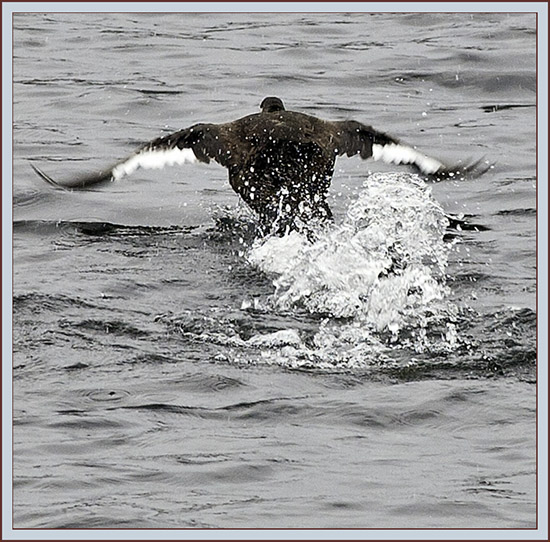
|
Around Camp Ellis - Saco, Maine...

|
Views from the Cormorant Stop...
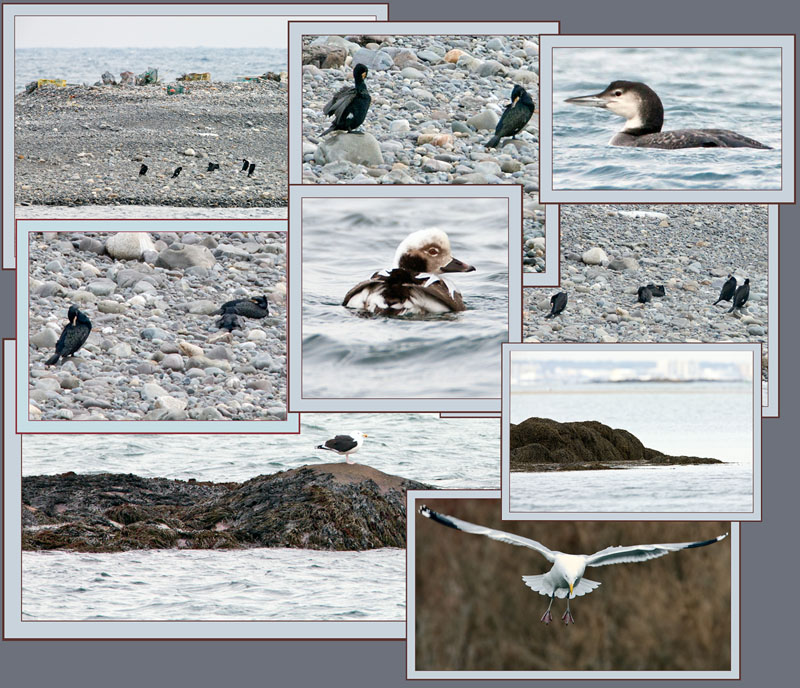
|
A Morning at Cape Neddick...

|
The next day was Sunday and I remained inclined to get out with my cameras for a time. I asked Linda if she wanted to take a ride to Cape Neddick in York. I hadn’t been there recently and this location always presents an opportunity of finding Harlequin Ducks, scoters and the like. She agreed and after the normal morning’s routine, we got on the road. It would be approaching low tide when we arrived which would preclude having ducks close in probably, but I could always photograph the buildings and lighthouse on Nubble Island. It was pleasant trip south and we enjoyed the day and comfort of the truck, not recognizing what the temperature would be like at this coastal location once we were outdoors… View Towards Nubble Island - York, MaineCanon EOS 1Ds Mark III, 1/30 second at f/22, ISO 200, TS-E 17mm f/4L. |

|


|
Besides the Cormorants in the distance around the point we could see Black Scoters, Black Ducks, a pair of
Harlequin Ducks – I was disappointed to not see a group on the
ledge where I generally found them in past visits, a Bufflehead or two and plenty of Common Eiders and gulls. As I walked about reconnoitering the area I also spotted a
single Snow Bunting. I brought my handheld camera up and got off two quick exposures, then went after my tripod and 600mm lens. The bunting was near the edge of the parking
lot and a van pulled in just as I returned. Of course, they had to park exactly in front of where the bird was located and it moved off. I relocated it on an exposed section
of ground and took some exposures but by then it was further away than I’d hoped.
Snow Bunting - York, MaineCanon EOS 5d/EF 400mm F/5.6L, 1/1000 second @ f/11, ISO 640. |
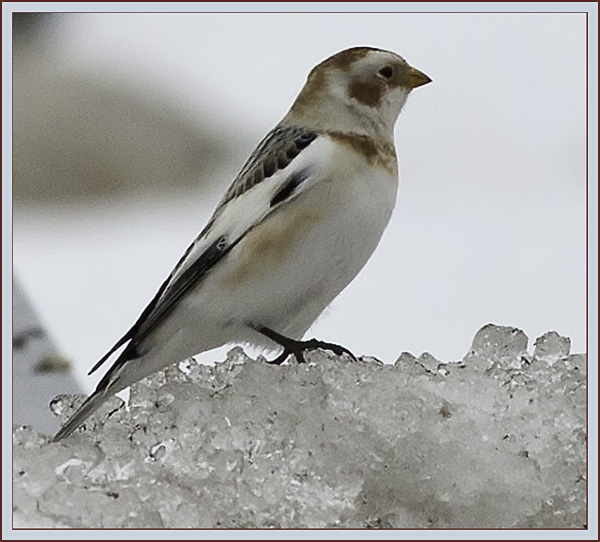
|

|
A Stop at Portland Harbor...
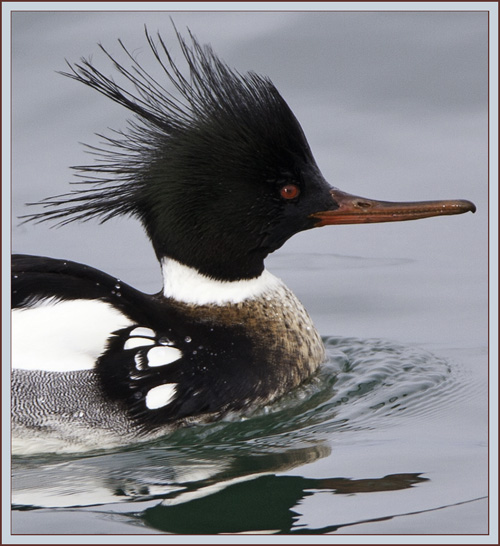
|
As we warmed up driving towards home, I asked Linda if she minded making a brief stop in Portland on the way through. She indicated this was fine so I drove to the Marine Trade Center to see what may be around. I’d been checking this spot frequently because you never know when an interesting subject may be close at hand. I spotted a Harbor Seal leisurely floating about and took some exposures. As the seal righted I came into the line of vision causing it to bolt upright for a closer look – the photograph of this scene can be viewed below… Red-breasted Merganser...Canon EOS 1Ds Mark III/EF 600mm + 1.4X = 840mm, 1/200 second at f/8, ISO 200 with extended flash. |

|
There were several Red-breasted Mergansers around as well as Common Eiders and Long-tailed Ducks further out in the channel. Generally a Common Loon can be found and
today was no exception – I observed the loon dive and soon return with a flounder. The bird was having some difficulty maneuvering the fish to swallow it. I photographed
the scene but because I didn’t reset my ISO since the York landscape sequences, had a slower shutter speed than the scene required so many of this series were tossed
out – even with shooting from a tripod. At the computer I determined this as being more due to wind than anything else. If I let the lens go it would instantly turn
into the gusting breeze, it hadn’t let up much all day.
Common Eider in Portland Harbor...Canon EOS 1Ds Mark III/EF 600mm + 1.4X = 840mm, 1/320 second at f/7.1, ISO 200 with extended flash. |

|


|

|
South Portland into Scarborough, Maine - February 18th...

|
Chuck and I had been exchanging emails and he mentioned a sighting of a King Eider at Pine Point in Scarborough. We decided to meet there on the following Friday afternoon to see if we could locate it. I started out stopping by Mill Creek in South Portland to look for the white-winged gulls and took a few shots, but didn’t stay long before leaving for Scarborough. I arrived earlier than what we’d planned as the afternoon advanced and scanned the area carefully with no luck. It was low tide offering a poor opportunity to sight a single duck in the distant bird activity. Even at high water much of the observing here is at long distance. I decided to get my cameras out to see what I could find… Herring Gull with Catch - South Portland, Maine...Canon EOS 1Ds Mark III/EF 600mm + 1.4X = 840mm, 1/250 second at f/8, ISO 800 with extended flash. |
It wasn’t long before Chuck came along with his significant other, Jenny. I was down on the mud flat and as he approached I indicated he stay where he was unless he didn’t
mind sinking in the mud as he walked. I decided to take some bracketed shots because I was starting into High Dynamic Range (HDR) photography and needed some data to
experiment with. Most have probably heard of this process, but to be brief, you capture at least three exposures – one metered at normal exposure, one at minus two and
another at plus two stops. At the computer these files are combined and enhanced using software dedicated to this task. I’d thought about this process often, had software to support
the effort and although I recognized it wasn’t useful for bird and some other subjects I preferred, wished to learn how to employ it. I did have a problem with the wind
(as usual these days it seemed), the exposures are best done in still air to prevent ghosting when the images are overlaid.
Chuck and Jenny at Pine Point - Scarborough, Maine...Canon EOS 1Ds Mark III/EF 600mm + 1.4X = 840mm, 1/320 second at f/7.1, ISO 200 with extended flash. |

|
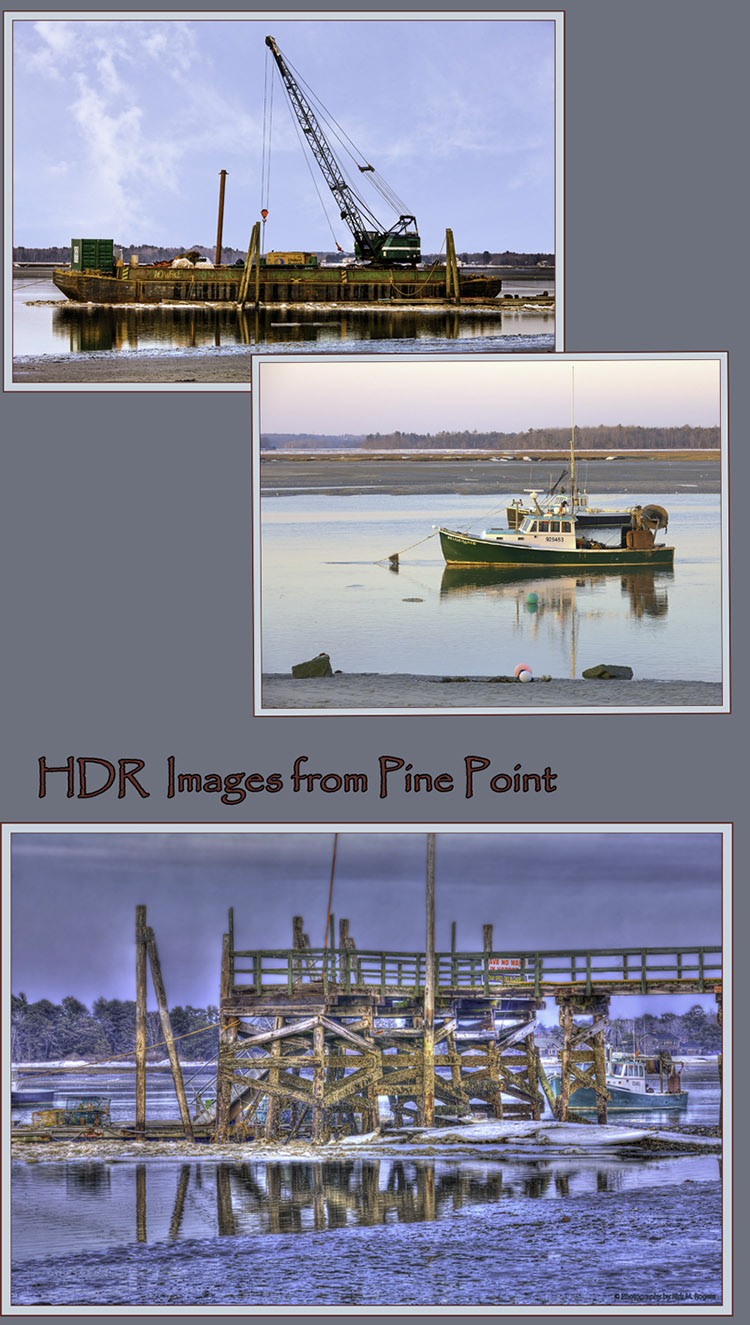
|
At Pine Point - Scarborough, Maine...
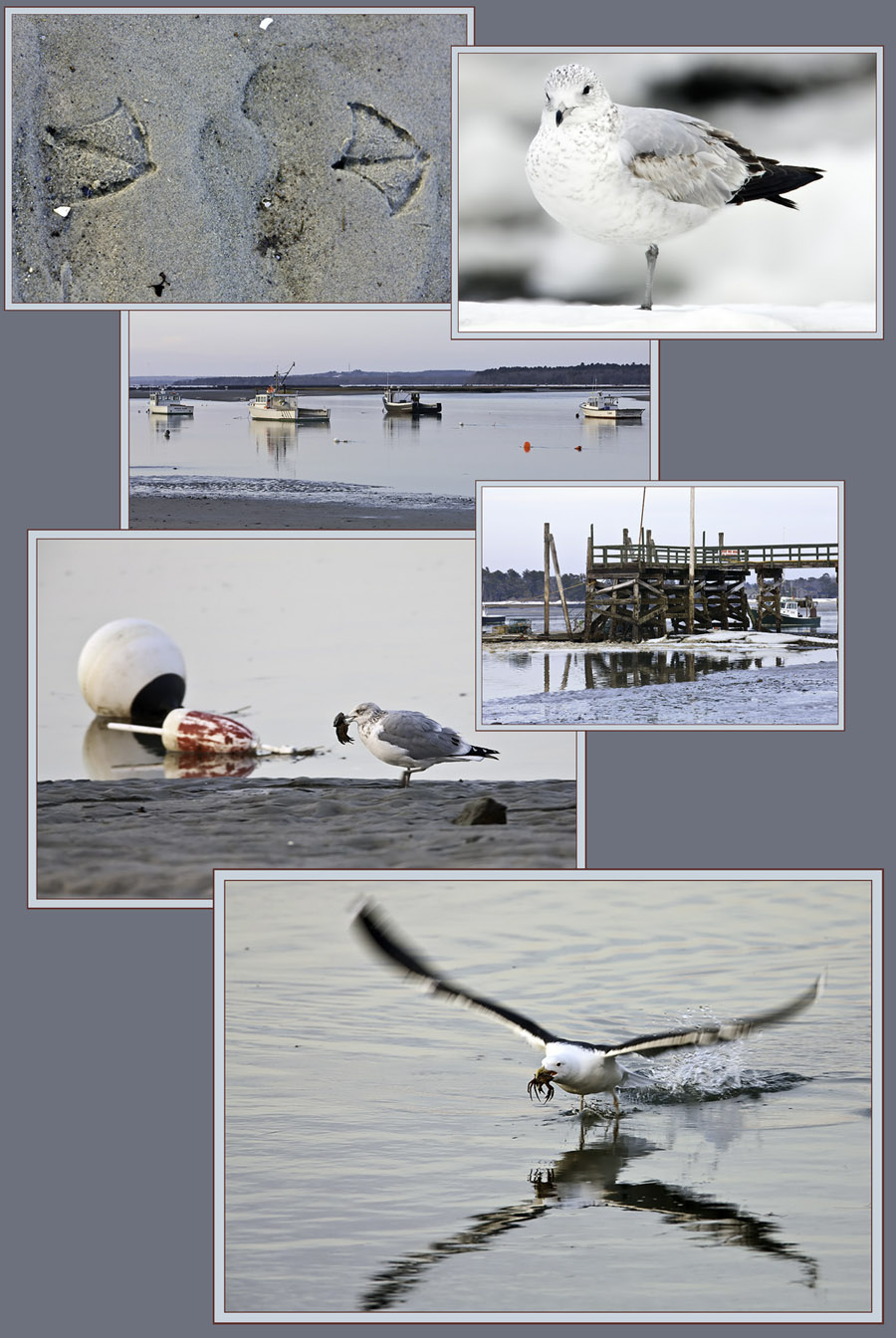
|
On the Ice - Thompson Lake, Oxford County, Maine...
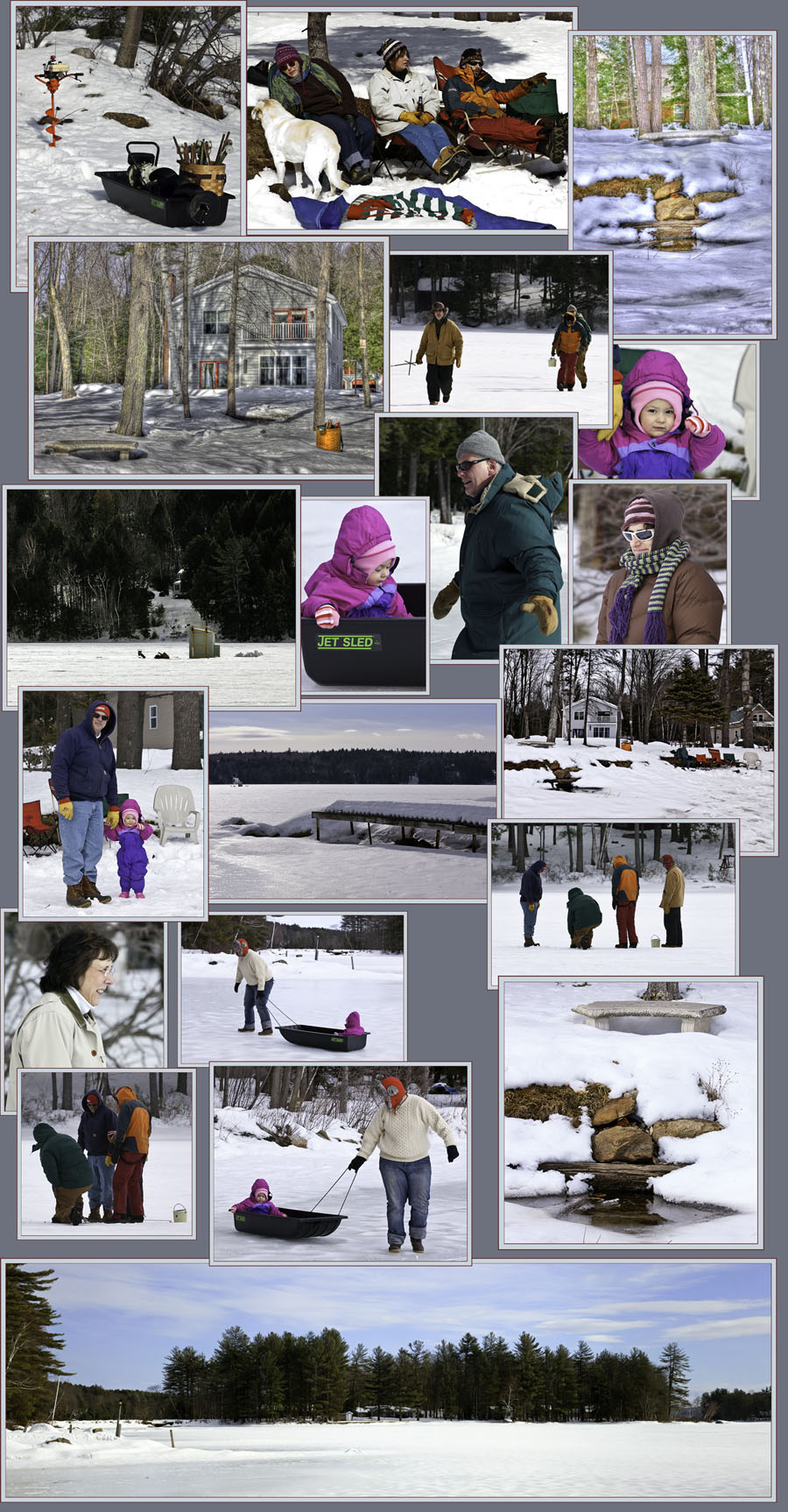
|
Kittery and a York Return - Sunday, February 20th...

|
Earlier in the week I’d emailed Chuck to learn if he had any time available this weekend. Saturday was out for both of us, but Sunday would work, and we decided to go to Kittery. There was a beach there he’d visited previously and observed some American Pipits, plus lots of other potential locations to check in the area. I was okay with this as I hadn’t been down there recently. I picked Chuck at home and we went on tour… HDR View of Fort McClary - Kittery, Maine...Canon EOS 1Ds Mark III/EF 600mm + 1.4X = 840mm, 1/2000 second at f/8, ISO 200. |
I’m not certain where we were exactly in the three or four Kittery stops we made. We visited the beach where Chuck observed the pipits - didn't see any pipits or much else for bird life
around, stopped at a pier and took some
exposures and stopped at a park to check it out but didn’t go outside the parking lot, just observed the ocean activity. In essence, we drove around following the water
looking for possibilities. I asked Chuck if he’d been to Cape Neddick recently and told him about the Great Cormorants I’d observed. It was on the way north so we decided
to stop there and at the Cliff House nearby on the return. One thing can be said with certainty about the day – it turned out to be the least amount of bird activity we’d
witnessed in recent times. This could have been weather related; it reached nearly twenty degrees and was sunny this day…
View on the Beach - Kittery, Maine...Canon EOS 1Ds Mark III/EF 70~200 IS II, 1/160 second at f/7.1, ISO 100. |

|
Some Kittery Views...
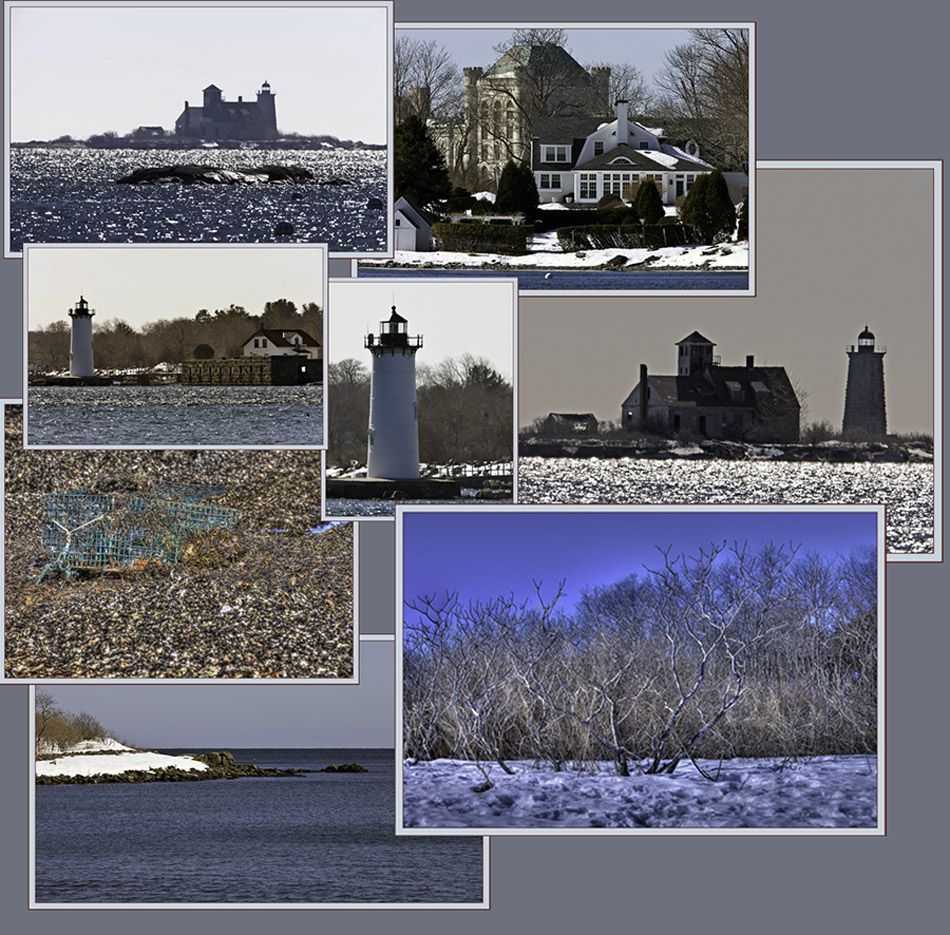
|

|
I set up the GPS to plot a course to Nubble Island as we checked the water along the road looking for birds or other photographic items of interest. We came to a road that was closed, may have been due to bridge construction, but as we looked ahead we observed a group of Buffleheads and other bird activity in the water. This worked out well, a closed road with no traffic, so I pulled over to have a look. As soon as we exited the vehicle the buffleheads starting moving off – these birds have wide-ranging comfort zones. We used the snow banks to screen our movements and took some exposures. We were within five miles of the lighthouse and were soon on our way… Bufflehead...Canon EOS 1Ds Mark III/EF 600mm + 1.4X = 840mm, 1/125 second at f/16, ISO 400. |

|
Nubble Island Revisited...

|
The lighthouse and grounds are maintained by the Town of York and are not open to the public. Sohier Park has free parking and an outstanding view of the lighthouse and
buildings, which include the 1879 Keeper’s house, 1902 oil house, a storage building and a boathouse circa 1978. The lighthouse standing today was constructed in 1879 of
cast iron lined with brick with a tower height of forty-one feet; it was automated in 1987. The original optic from 1879 was a Fourth Order Fresnel, typically used in
major harbors to guide mariners into a channel or harbor mouth, or to mark shoals and islands. This was replaced by an optic of the same order in 1928. I do not doubt
that this site is visited as often as the Portland Head Light in Cape Elizabeth - both are major tourist destinations. It’s been remarked that the two are some the most
frequently photographed lighthouses in the world, although I have no clue what basis is used to opine this determination.
HDR View of Cape Neddick Light - York, Maine...Canon EOS 1Ds Mark III/EF 70~200 IS II, Three Exposures at f/11, ISO 200. |

|
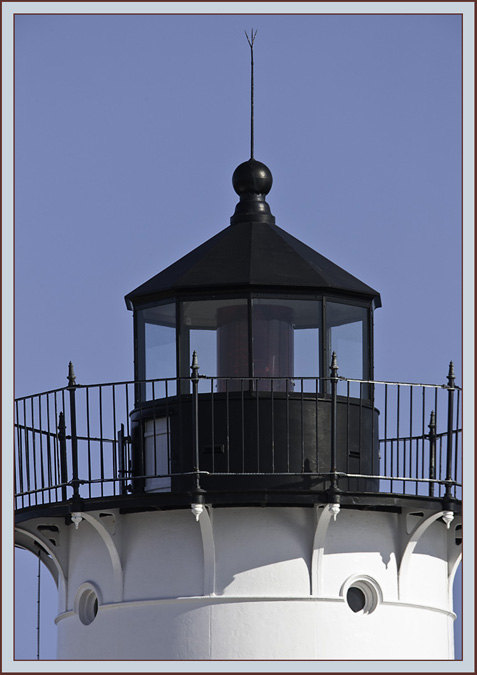
|
It wasn’t exactly warm at Sohier Park but the sun was out and so were the people. Vehicles were coming and going, many with out-of-state plates – the place was booming considering it remained in the grip of a cold February. And they all had cameras out photographing Nubble Island and the beautiful landscapes around us. It would be difficult to find a more scenic venue than Nubble Light, but there are two particularly nasty telephone poles to the left of the house with a plethora of wires running across the channel. The wires also run across the face of the ledge and because there is little way to vary the scene by repositioning your camera angle – it’s all ledge surrounded by water, I suspect these are some of the most photographed poles and wires to be found anywhere. You can go tight on the composition, perhaps shoot the scene as you wish and take out the obstructions with software, or do as I suspect most do – leave the scene intact poles and all. I did a bit of all three with the group exposed this day… View of the Fourth Order Fresnal Optic...Canon EOS 1Ds Mark III/EF 600mm + 1.4X = 840mm, 1/800 second at f/8, ISO 400. |
Images Around Sohier Park - York, Maine
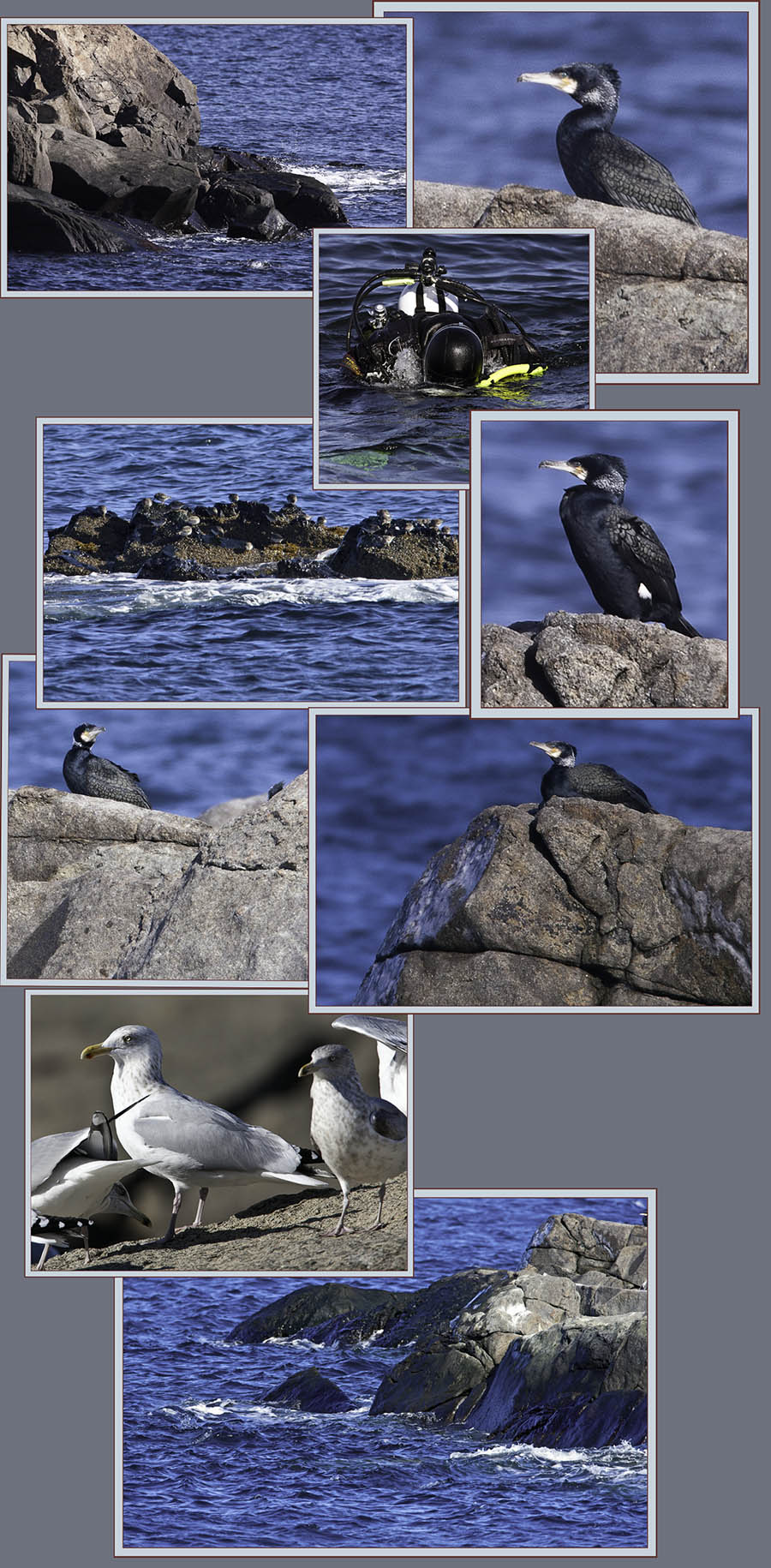
|
A Few of Kiro's Views of Nubble Island...
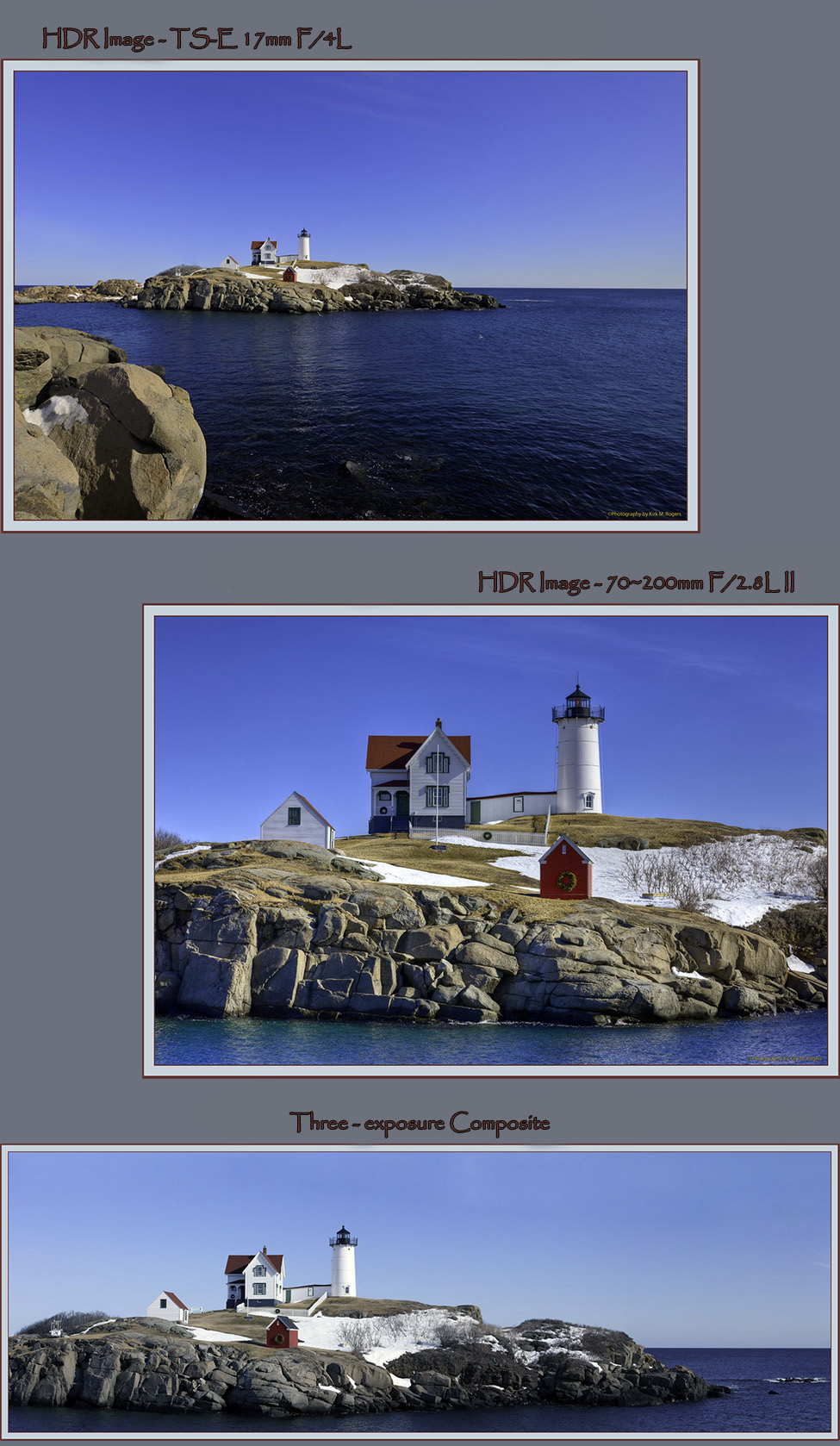
|
We made one more stop on the way home – the Cliff House in Ogunquit. This inn and facility is closed in winter but offers some outstanding views from the cliffs down to
the sea below. We observed many sea ducks from our vantage point, all too far distant to consider a photographic effort. We saw a pair of ladies with binoculars heading our
way, the only people around, and we suspected they must be birding. As they approached Chuck asked what they’d observed, afterwards to which they indicated we should go to the other side of the
facility, down the service road, because many Harlequin Ducks were in the area. So we did… These ducks were closer but by no means nearby, however, we thought it would be
worth a few exposures and geared up accordingly. The problem was getting to the edge of the cliff – a significant mound of snow was ahead of us, obviously this was the
collection point when clearing the grounds. Chuck said he’d see if we could get over it and learn what was on the other side before I tried it carrying the tripod through. It did
work out in the end result, but there was one section where a step would find no bottom and I was quickly mired in the snow, unable to get out while holding the tripod. Chuck
came over and helped out and soon we were maneuvering for the best vantage point. Thinking back on this now I find it difficult to believe I didn’t bring a wider lens along to
photograph the cliffs – the scene would have been compelling. But as it was we were equipped with longer focal lengths only, so we walked the grounds, took some exposures on
the ducks and left. Getting out was easier – Chuck went ahead of me and opened up the deeper holes by widening them, allowing ample room to pull legs and ankles out…
Harlequin Ducks...Canon EOS 1Ds Mark III/EF 600mm + 1.4X = 840mm, 1/400 second at f/8, ISO 400. |
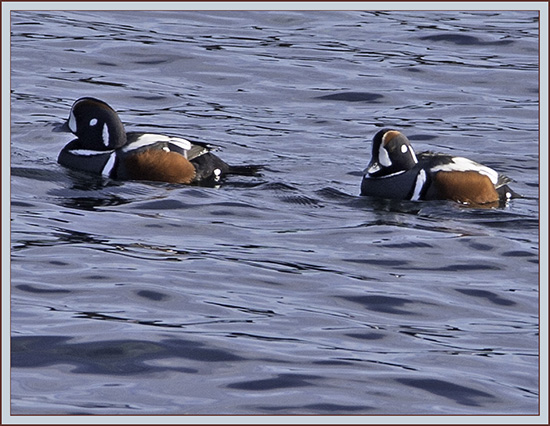
|
Views from the Cliffs - Ogunquit, Maine...

|

|
The weekend of February 25th started earlier than planned from a work standpoint. Another snowstorm moved in dumping nearly ten more inches and by afternoon the driving was treacherous enough that many businesses and offices closed early. I agree with this concept, even with the havoc it sometimes wreaks, because getting people off the roads and letting the public works crews clean things up is the best course of action. Everyone was quite tired of shoveling, snow-blowing, plowing and moving snow by now and fortunately, March was right around the corner. Southern Maine had experienced a Common Redpoll invasion around this time. I looked out the window one morning and stated to Linda a large group of American Goldfinch were around the feeders. We hadn’t seen goldfinches around of late and this was a good sign. Then I looked a bit closer – wait a minute – those aren’t goldfinch, but about two-dozen Common Redpolls. This was the first time I ever recall seeing these birds around our place – this was a pleasant surprise. We have a large maple tree in our backyard which presents excellent cover for birds to perch and check things out before shooting down to the feeders. While looking out an upstairs window at the maple I was nearly at eye-level with many of the redpolls. So when I got home mid-afternoon on Friday, I pulled the screen off the window, placed a 1.4X extender on my 400mm prime lens with a flash extender and started photographing birds in the snowstorm… Backyard View in a Snowstorm - Portland, Maine...Canon EOS 1Ds Mark III/EF 24-105 f/4L at 55mm, 1/250 second at f/9, ISO 800. |
I tried some HDR images on the tree from a tripod at first – no easy task with the room available around the window. I gave up on this – the wind kept the snow-heavy branches
in motion non-stop. So I set up for bird photography. I had about an hour of good light and as long as I kept the lens out of the snowflakes I was good to go, standing up &
shooting handheld through the opened top sash. Over the next hour or so I photographed many Common Redpolls; three Mourning Doves hunkered down in the tree, a pair of House
Finches, Dark-eyed Juncos and a White-breasted Nuthatch that I could only capture on the feeder – this bird was either on a feeder for a few seconds or out of sight…
Common Redpoll...Canon EOS 1Ds Mark III/EF 400mm + 1.4X = 540mm, 1/250 second at f/10, ISO 800 with extended flash. |

|
Backyard Blizzard Birding with a Lens - Portland, Maine...

|
Backyard Views...

|
The Final Session, February 25th - Cape Elizabeth, Maine...
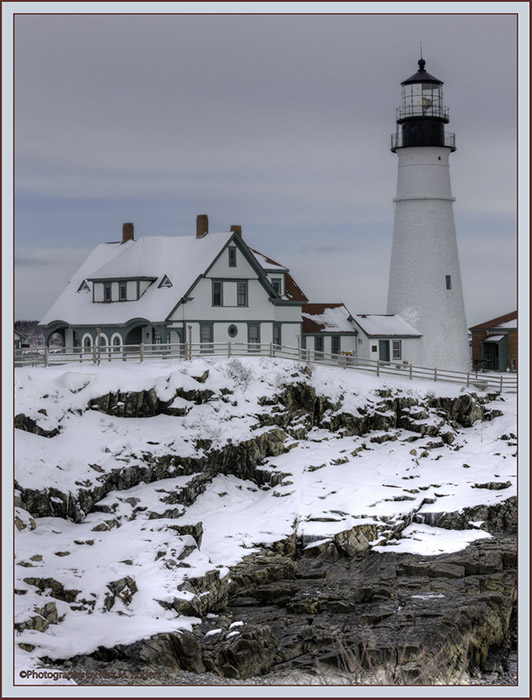
|
February was nearly done… I’m adding the last imaging session of the month to conclude this photojournal. I’d been planning to capture some winter scenes. With the newly fallen snow the trees and branches were still covered and if I could locate the right spot there was a possibility of a pristine environmental shot. It was the last Saturday of the month and I was considering making the drive to Pemaquid Point, one of my favorite places. I ended up revising this plan, the recent snow was being cleared away and I didn’t want to get to Pemaquid to learn the roads weren’t passable. In lieu, I packed the gear and traveled to Cape Elizabeth, Fort Williams Park and the Portland Head Light. As it turned out, I was more than pleased with the results from the day… Portland Head Light in HDR, Cape Elizabeth, Maine...Canon EOS 1Ds Mark III/EF 70-200 f/2.8L II, varied exposure, ISO 200. |
Today was an unusual circumstance for me. Although I planned to look for birds and was equipped to photograph them, I planned this session around landscapes
and bracketed exposures to produce HDR images. I didn’t observe any birds near enough to pull out the 600mm lens and tripod. This day would consist of shorter
focal lengths and the medium duty tripod in the field. I started out at the light and worked my way around the park grounds from there…
Winter Scene...Canon EOS 1Ds Mark III/EF 24-105mm f/4L, varied expsoures at at f/14, ISO 200. |

|
Kiro's HDR Views of Portland Head Light...
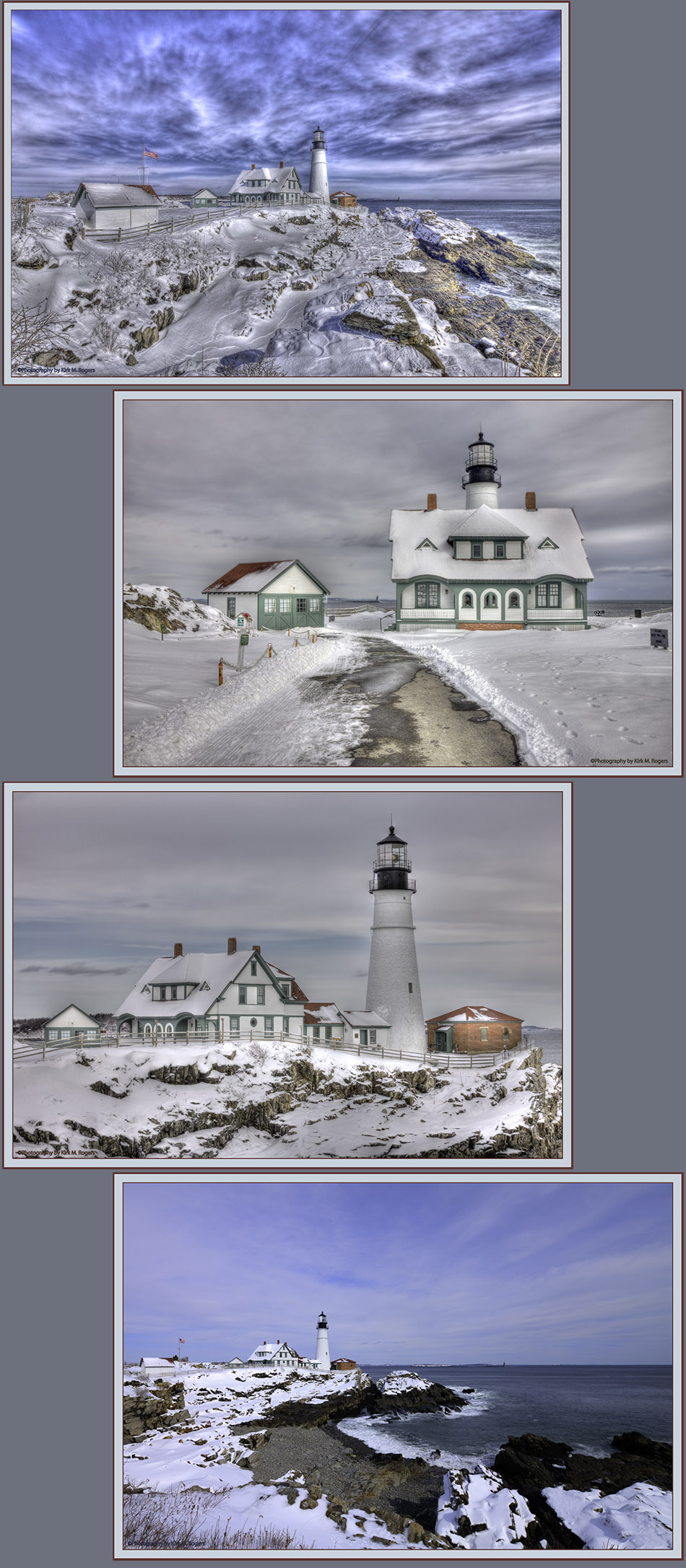
|
HDR Views Around Fort Williams Park...

|
The Final Template - Fort Williams Park...
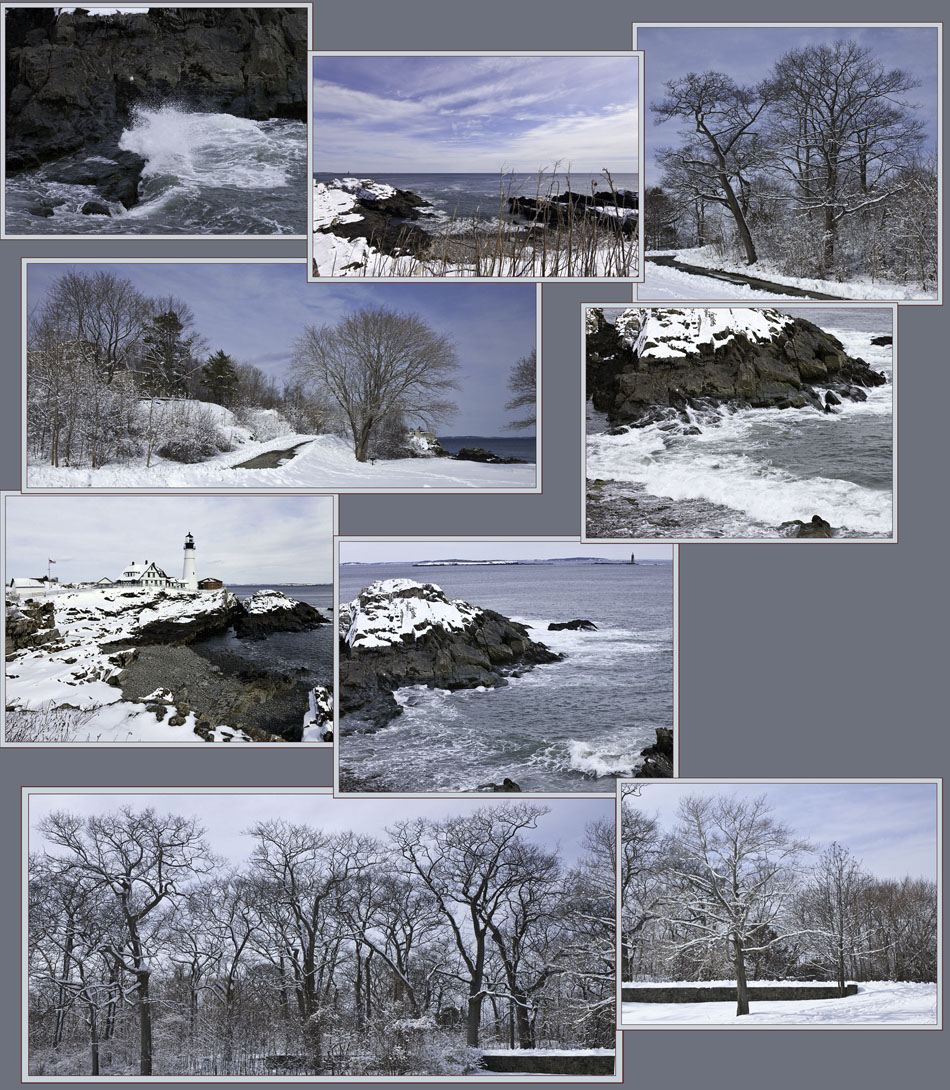
|

|
This article has taken us through two typical winter months in the State of Maine. Hopefully this has provided a respectable sampling of one photographer’s viewpoint through a cold and snowy time in New England. Spring isn’t far off – until then I hope you stay warm, dry and happy… As for me – I’ll be seeking the next opportunity for some time in the field, maybe in warmer weather, maybe not. There was discussion of a visit to a Black bear den looming… Winter at Home - Portland, Maine...Canon EOS 1Ds Mark III/EF 70-200 f/2.8L II, 1/800 second at f/10, ISO 320. |

|
Kiro
March 2011
March 2011